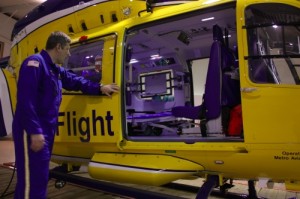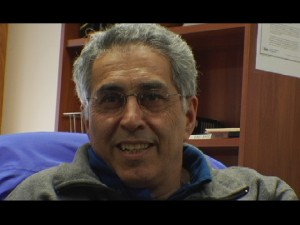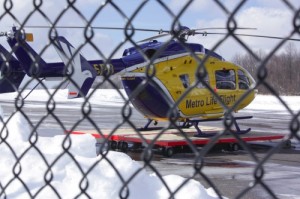We’ll Save Your (Anonymous) Life
CLEVELAND, Ohio — Sometimes the best thing a nurse can do for her patient is take a picture. Liz Pastis, Metro Life Flight nurse, was on standby at the hospital watching as medical staff cared for a dying baby. The family was watching, too. She asked if she could help, but the hospital staff was already too crowded around the baby. So Pastis waited. And as she watched, knowing the baby would die, the idea struck her: This family won’t have any pictures of the baby while he or she is alive. So she hustled to get a disposable camera and came back to take snapshots of the family with their new baby. But these are her interactions as a nurse.
Should We Go?
The pilots on her team never would have seen those events unfold. Based out of the Cleveland MetroHealth Medical Center, Life Flight is like “bringing the emergency room to the accident scene,” says pilot John Cox. It provides helicopter transport to patients in need of critical care. Sometimes the pilots help carry equipment or move the patient from the hospital bed to the helicopter, but the pilots don’t get a patient report. Patient information is on a need-to-know basis.
The pilots feel that’s how it should be. In order to make each flight safe, they need to focus on the flight. “Should we go or shouldn’t we go? That’s where the difficult part of the decision making happens,” says Jamal Jamili, Metro Life Flight pilot. Another pilot, Fin Molloy, says the pilot’s job is primarily to fly the aircraft and transport the medical crew safely. But another part of the job is just waiting for that call that someone needs help. Pilot John Cox sits in his blue jumpsuit, yellow stripes running down the left and right sides. He watches the Olympics. Germany is beating the United States in curling. He is debating whether curling is really a sport. Sometimes, particularly in the winter months, this is how the pilots’ day goes when they don’t get a call. Other days they receive many calls, and it can be hard to ignore what’s happening in the back of the helicopter. “You might choose not to look at the patient,” Molloy says. “You might choose not to go into the back of the squad.”
Oh No — It’s A Kid
But it’s not always that easy – especially when it comes to children. Jamili can get emotional when kids are involved. One incident that affected him happened a few years ago. Three teenagers drove over a cliff west of Cleveland. All of them died in the crash. “That’s just . . . wow. It really affects you. I remember even today that accident,” he says.
And sometimes they just hope it’s not their own child who needs the flight. Melvin Steedly, Metro Life Flight pilot, got some advice from a colleague when he first started the job.

Pilot John Cox inspects his aircraft during a lull. The father of a teenage son, Cox always worries when they get called to a car accident in his hometown.
“He said ‘Melvin, you can’t focus on it. You gotta do your job.’ and that was the best advice I got,” Steedly says. Then one time, Steedly did know the patient. He was in the emergency room when he heard someone behind the curtain say “Yeah, and I worked with him at GE.” When Steedly looked, he realized it was his friend talking. “My general greeting is, ‘How you doing?’ Well, he’s in the emergency room,” Steedly says. “I’m not gonna ask him how (he’s doing). So I saw him and I said, ‘Rick, some people will do anything to get a helicopter ride.'” Rick started laughing which got his mind off the heart attack he was starting to have.
They got Rick loaded into the helicopter for transfer to a cardiac center. “That’s where you don’t think about it,” Steedly says. “You think about your mission.” Metro Life Flight responds to auto accidents and house fires as well as patient transfers between hospitals throughout Northern Ohio, Northwest Pennsylvania and parts of Michigan. They travel with two pilots, a doctor and a nurse, giving the team an advantage over an ambulance’s paramedic staff; the team can start treating the patient and administering medications immediately.
Always, It’s The Weather

Pilot Jamal Jamili takes a short break and checks the weather again after returning from a successful flight.
The Flight Control Office pages them with a call. This time they need a flight from Medina to MetroHealth Medical Center in Cleveland, but outside the snow snaps in a hundred directions. Cox says the weather is hovering just above the minimum flight requirements, and the crew may not accept it. The pilots pore over radar screens and weather reports on the computer. The four staff members — two pilots, a doctor and a nurse — have to decide together whether they take a flight, so they wait to receive patient reports in order to remain objective.
Weather can be a major safety concern and has a lot of hard-to-predict variables, Jamili says. Finally, they determine this flight won’t happen. They call the FCO back and tell them the Lorain base might have a better shot. “It takes four to go, one to say no,” Pilot Melvin Steedly says. “If one person objects, we don’t go. Anybody on the team – the med part or the pilots – can cancel the flight.”
Theresa Edwards is a senior newspaper journalism major at Kent State University.

Sorry, the comment form is closed at this time.